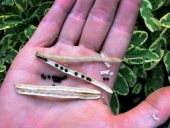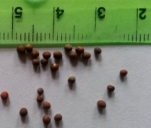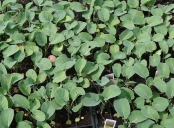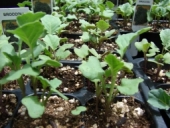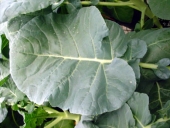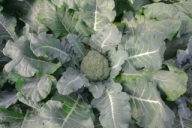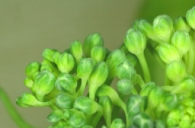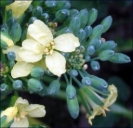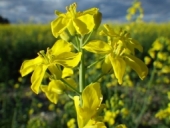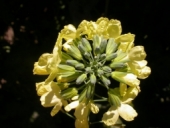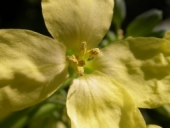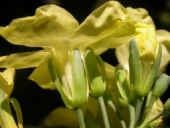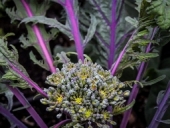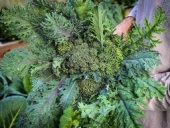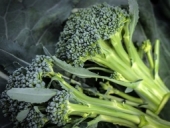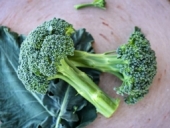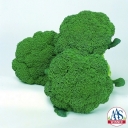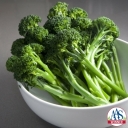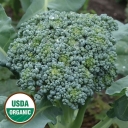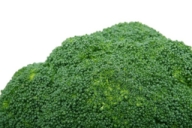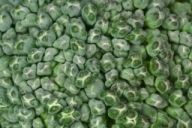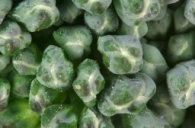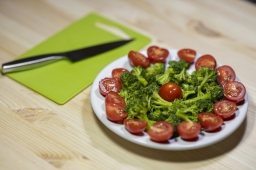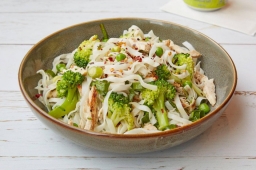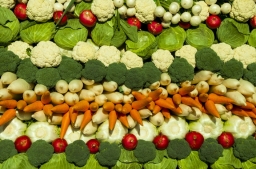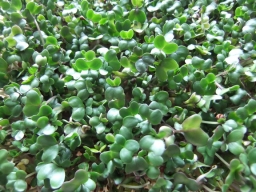| Broccoli, sprouting - Brassica oleracea (Italica group) | ||||||||||||||||||||||||||||||||||||||||||||||||||||||
|---|---|---|---|---|---|---|---|---|---|---|---|---|---|---|---|---|---|---|---|---|---|---|---|---|---|---|---|---|---|---|---|---|---|---|---|---|---|---|---|---|---|---|---|---|---|---|---|---|---|---|---|---|---|---|
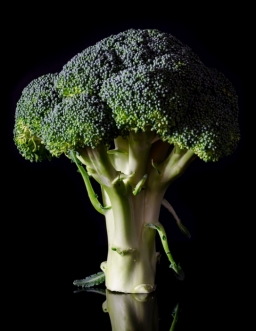 Fig. 1  Brassica oleracea L. var. italica 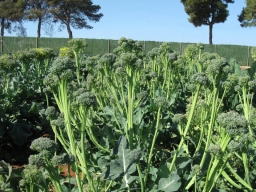 Fig. 2  Cultivar 'Artwork' F1 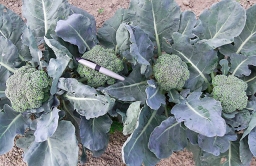 Fig. 3  A heat-tolerant broccoli hybrid in an ARS research field, South Carolina. The marker pen indicates optimal head size for harvest. 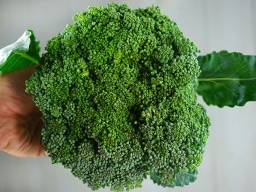 Fig. 4  Cultivar 'Waltham 29' 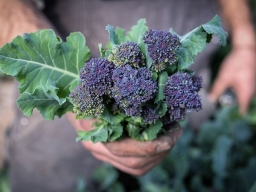 Fig. 4  'Early Purple Sprouting' broccoli A sublime wintertime treat, buttery soft, nutty-flavored broccoli from the U.K. Listed in John Mason’s seed catalog in 1793. 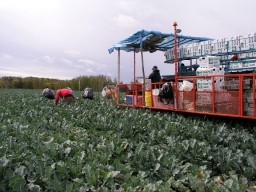 Fig. 5  Broccoli harvest 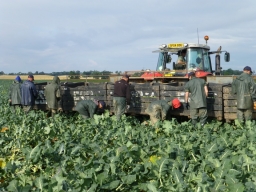 Fig.
6 Fig.
6  Broccoli harvest 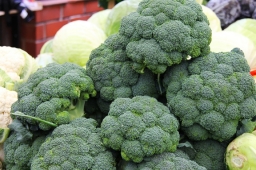 Fig. 13  Market 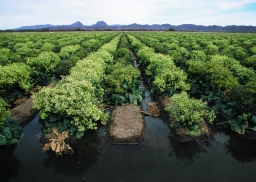 Fig. 14  Furrow flood irrigation on a field of broccoli raised for seed, Yuma, AZ 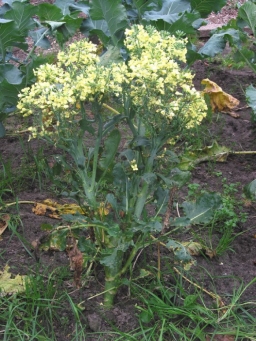 Fig. 15  Broccoli in flower 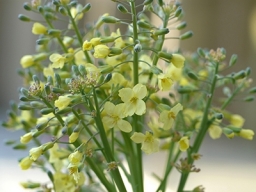 Fig. 16  When this broccoli's flowers dry up, the seeds can be harvested 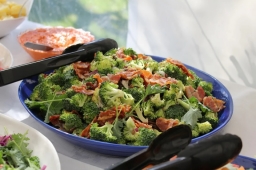 Fig. 33  Lettuce, broccoli and bacon salad 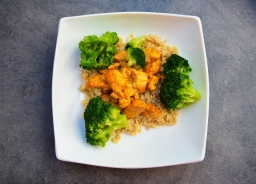 Fig. 34  Chicken, rice and broccoli 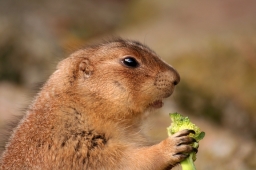 Fig. 35  Prairie dog |
Scientific
name Brassica oleracea L. var. italica Common names English: asparagus broccoli, broccoli, Calabrese, Cape broccoli, heading broccoli, purple cauliflower, sprouting broccoli, winter broccoli; Chinese: lu hua cai (绿花菜); French: brocoli asperge, chou brocoli; German: Brokkoli, Spargelkohl, Sprossenbrokkoli; Italian: cavolo broccolo; Portuguese: brócoli; Spanish: brécol, brecolera, brócoli 8 Synonyms B. oleracea L. var. botrytis, B. oleracea L. subvar. cymosa Duchesne Relatives Branching cabbage, perennial kale, B. oleracea L. var. ramosa DC.; Brussels sprouts, B. oleracea L. var. gemmifera DC.; Chinese broccoli, Chinese kale B. oleracea L. var. alboglabra; cauliflower, B. oleracea var. botrytis; cabbage, B. oleracea L. var. capitata L.; collards, B. oleracea L. var. viridis L., B. oleracea L. var. acephala DC.; curly kale, B. oleracea L. var. sabellica L.; Jersey kale, tree kale, B. oleracea L. var. palmifolia DC.; kale, B. oleracea L. var. viridis L., B. oleracea L. var. acephala DC.; kohlrabi, B. oleracea L. var. gongylodes L.; marrow-stem kale, B. oleracea L. var. medullosa Thell.; Savoy cabbage, B. oleracea L. var. sabauda L.; seakale cabbage, B. oleracea L. var. costata DC., B. oleracea L. var. tronchuda L. H. Bailey; wild cabbage, B. oleracea L. var. oleracea 8 Family Brassicaceae/Cruciferae (cabbage/mustard family) Origin Mediterranean area and Asia Minor 2 USDA hardiness zones 6-9 5 Uses Vegetable: flower buds; medicine: folklore 8 Life cycle Annual Seed Season Cool Planting dates North: Aug-Feb; central: Sept-Feb; south: Oct-Jan 1 Days to harvest 75-90 (50-70) 1 Soil tolerance Wide range, well drained, organic-amended 9 pH preference 6.8-6.0 3 USDA Nutrient Content: raw, cooked pdf Light requirement Full sun: 6-8 hours Water requirement Keep plants moist, not drought tolerant 11 Salt tolerant May be planted near coastal areas Cold tolerance Very cold hardy. Possibly killed: 26-32 °F (-3-0 °C) for 30-36 hours; possibly stunted: 30's °F for 20 or more days 1,2 Temperature requirement 65-80 °F (18-27 °C) 11 Invasive potential * None reported Known hazard Vertebrate poisons: mammals (to ruminants, as B. oleracea var. botrytis) 8 Reading Material Broccoli—Brassica oleracea L. (Italica group), University of Florida pdf Broccoli, UF Gardening Solutions Cole Crop Confusion, UF Gardening Solutions Origin Descended from wild cabbage native to the Mediterranean coast, broccoli was bred by the ancient Etruscans. It has been popular in Italy since the days of the Roman Empire. However, records indicate this vegetable was unknown in England until a relatively recent few hundred years ago. Although Jefferson grew it at Monticello, broccoli would not become commercially grown in the U.S. until the 1920s. In Florida, broccoli is probably grown to a slightly greater extent than in other areas of the country, comparing favorably with beets and garden peas in frequency of production. Broccoli is well-adapted to all areas of Florida when grown during the coolest months of the year. 2,11 Description Previously known as: Raphanus brassica-officinalis. 15 Broccoli has two different distinct forms. One is sprouting broccoli, which makes a somewhat branching cluster of green flower buds atop a thick, green flower stalk, and smaller clusters that arise like sprouts from the stems. This form, called calabrese in Britain, is the most commonly grown form in the United States. 2 The other type of broccoli makes a dense, white curd like that of cauliflower and is called heading broccoli or cauliflower broccoli. This latter form is usually grouped with cauliflower, leaving the term broccoli restricted to sprouting varieties. 2 Calabrese is the less hardy and is used mainly as an autumn and early winter crop. They are very winter hardy and are grown outdoors through the winter to provide a spring to early summer crop. 2 Seed Seeds are similar to cabbage seeds. 6 Direct seeding can be done 2-3 weeks before last frost. Since direct seeding may result in poor stands, broccoli can be started by using vigorous 4- to 5-week-old transplants. 2,11 Seed viability 3 years 4 Soil depth 8-10 in. (20-25 cm) 9 Seed depth ¼–½ in. (5-10 mm) 1 Yield per 10 ft (3 m) 5 lb (2.3 kg) 1 Growth temperature 65-80 °F (18-27 °C) 11 Germination temperature Approximately: 75 °F (24 °C) 11 Days to germination 8-10 11
Fig. 7. Broccoli seeds with dried seed pods, Bonsallo Avenue Urban Garden Fig. 8. Graines de brocoli, measurement: cm Planting Easily survives transplanting. Seedlings should be hardened off before planting them in the spring by leaving them outside for a few hours every day. After three days, plants can be left overnight. 1,9 Plants stunted by low temperatures form small central flower buds and very few side shoots. 2 Spacing (inches) Plants: 10-15 in. (25-38 cm); row: 24-40 in. (60-100 cm) 1 Plants per 10 ft2 (3 m2) 8-12 3 Plant population (acre) 10,400–26,000 1
Fig. 9. Broccoli plants in a nursery, Cranford, New Jersey Fig. 10. B. oleracea var. italica, Maui, Kula Ace Hardware and Nursery Leaves The leaves of practically all the cabbage family are edible, but the strong flavors of some species are disagreeable or too strong for most people's taste. 16
Fig. 11. Broccoli (B. oleracea, Italica group) leaves are similar to collards, but much smaller Fig. 12. Broccoli 'Southern Comet' Bolting If you're new to vegetable gardening, you may have heard the term "bolting." But what does it actually mean? Bolting is another way to say that a vegetable plant has started to flower. It can happen in spring when cool-season crops respond to the warmer temperatures and longer days. Crops that often bolt include Brussels sprouts, broccoli, lettuce, collards, and other greens. The trouble is that bolting can affect the quality of your harvest. As plants put more energy into flowering and setting seed, the vegetables will start to taste bitter. Pinch off any flowers as they appear, and you may be able to extend your harvest season by a few weeks. Look for seed varieties that are labeled as "slow bolting". 7 Flowers Buds open into tiny yellow flowers, which are edible. 6,15
Fig. 17. Extreme close-up of broccoli florets Fig. 18. Flowers opening Fig. 19. B. rapa, the inflorescences and flowers are very similar among the different species and varieties of Brassica (e.g., four large yellow petals alternating with four sepals and six stamens, numbers distinctive to the mustard family Brassicaceae) Fig. 20. B. oleracea var. italica, raceme, top view Fig. 21. Stamens Fig. 22. Sepals Seed saving Broccoli will cross pollinate with all B. oleracea crops. Minimum isolation should be 1600 ft for home use and 1-2 miles for commercial production. Pods will start to dry and turn brown as they mature. If the seed pods are allowed to dry completely in the field, you run the risk of them shattering. It is best to harvest the mature plants and allow them to dry completely on tarps. 17 Varieties/Cultivars Recommended varieties for Florida are: 'Atlantic', 'Early Green', 'Early Dividend', 'Green Comet', 'Green Duke', 'Green Mountain', ‘Italian Green Sprouting', 'Waltham', ''Packman', 'De Cicco', 'Spartan Early', 'Rapini' (Broccoli Raab). 1 Commercial plantings also include the hybrids: 'Abrams', 'Burney', 'DuraPak 19' (for northeast Florida), 'Eastern Crown', 'Green Magic', 'Imperial'. 3 Varieties of broccoli vary considerably in garden performance. The old standard ‘Waltham 29’ (Fig.4,25) still is a top choice. It is ready to cut from 80 to 100 days from transplanting and continues to form side shoots (secondary heads) after the main central head is cut. 'Baby Broccoli' seed has become available to home gardeners in recent years. Pinch the main head out when it is the size of a nickel so that your plant sends out the tender stemmed side shoots. Regular harvesting will increase yield. Varieties include 'Artwork' F1 (Fig.2), and 'Aspabroc' F1. 14 'Broccoli Raab' is an heirloom type, harvested when florets are very small and tender. Like 'Baby Broccoli', regular harvesting will increase overall all yield. 'Broccoli Raab' matures quickly so keep an eye on it. Varieties include 'Rapini', 'Zamboni', and 'Sessantina Grossa'. 14 Cauli-broc has the tender texture and sweet flavor of broccoli, but has a lime-green head similar to cauliflower. 2
Fig. 23,24. 'Purple Peacock.' The entire plant is edible. A small broccoli with frilled, kale-like leaves and tasty purple heads. Frank Morton of Wild Garden Seeds married 'Green Goliath' broccoli with two different kale varieties, and the result is the most beautiful and versatile broccoli we have ever seen! Fig. 25. 'Waltham 29.' Standard type, produces 4-8 inch green heads that are nicely flavored. Compact plants also produce some side shoots. Introduced in 1954. Fig. 26. 'Calabrese Green Sprouting' broccoli. An Italian heirloom brought to America in the 1880s; 5 to 8 inch heads and many side shoots. Fig. 27. 'Green Comet.' 1969 AAS Edible – Vegetable Winner Fig. 28. 'Artwork.' 2015 AAS Edible – Vegetable Winner." Artwork starts out similar to a regular crown broccoli but after harvesting that first crown, easy-to-harvest tender, and tasty side shoots continue to appear long into the season, resisting warm temperature bolting. Fig. 29. 'De Cicco.' An Italian broccoli introduced to the United States in 1890. Compact 2-3' plants produce a 4" central head. After the central head is harvested, a second yield of edible side shoots will develop. Harvesting The central head should be harvested first when it is still tight and compact, with no opened flowers. It takes from 60 to 100 days from planting to first harvest. As much as 5 inches of the flower stalks should be cut along with the buds. Cut the stems at an angle to keep water and diseases at bay. Do not allow the stems to become tough and woody. After the central head is removed, side shoots will develop. Although smaller, these should be harvested at 2-4 day intervals. The entire harvest period may run from 40 to 80 days, depending on the season, crop condition, and locality. 2,9 Outer leaves can be harvested sparingly before the flower buds form and more intensely by the end of the season; use similarly to collard greens. If the plant does flower before harvest, flowers and young seed pods can be eaten raw in salads or as a garnish. 15
Fig. 30,31,32. Close-ups of broccoli florets Storage Cook or steam broccoli or refrigerate the heads soon after harvesting. Broccoli can be frozen by steam-blanching prior to freezing. Vegetables with higher respiration rates, such as broccoli, must be rapidly cooled to the optimal storage temperature to slow metabolism and extend postharvest life during subsequent shipping and handling operations. Broccoli may be stored for 10-14 days at 32° F (0° C) at 95-100% relative humidity. 9,10,12 Fertilizing Broccoli is a fairly heavy feeder and will require additional nutrients. After initial fertilization at planting, apply 2 pounds of 5-10-15 fertilizer or equivalent per 100 square feet of bed each month during the growing season. Mulch broccoli with pine straw or leaves to keep weeds away and to preserve moisture in the soil. 9 Irrigation Broccoli requires proper irrigation to achieve optimum growth. Water plants daily for the first week to get the crop established. Continue to irrigate broccoli every four to five days, as needed, to keep the plants healthy. 9 The critical period of water needs is during head development. 11 Culture Although broccoli is a cool season vegetable, it is susceptible to cold injury, especially when the plants are tender and not conditioned to withstand low temperatures; it will still benefit from protection from low temperatures (32 °F (0 °C) or cooler). 2 Pests/Diseases/Weeds Avoid deeply cultivating near plants as they have shallow roots. 11 Florida Crop/Pest Management Profile: Cabbage, University of Florida pdf Weed Control in Cole or Brassica Leafy Vegetables, University of Florida pdf (Archived) Food Uses Broccoli can be steamed, boiled, microwaved, baked, eaten raw or sautéed. 13 Steaming or microwaving broccoli for a short period of time with a little water is the best way to preserve its nutrients. 13 To roast broccoli, toss with a bit of olive oil and a dash of salt. Spread the broccoli out on a baking sheet and place in an oven set at 400 degrees F until the desired doneness is reached. 13 Broccoli is a great addition to casseroles, stir-fries, soups and salads. 13 To freeze, wash and cut broccoli into florets. Steam or blanch for about five minutes. Plunge into a bowl of ice water, drain and place in freezer-safe bags to freeze for up to one year. 13 Avoid broccoli with brown stems or yellow florets when shopping. 13 Broccoli florets are an easy way to get your nutrition but don’t forget about the stalk. The peeled stalk has very good flavor and texture – very similar to kohlrabi sticks. You can find julienned broccoli stems in your local grocery as “broccoli slaw”. And don’t forget about the baby broccoli, seen in grocery stores under the brand name of Broccolini™ but also available as seed for the home gardener. Another broccoli relative is the Italian heirloom broccoli raab. 14
Fig. 36. Broccoli and tomato salad Fig. 37. Chicken broccoli pasta Fig. 39. Five day old organic broccoli sprouts Nutritional Value Broccoli is high in nutrients such as vitamin A, vitamin C, folate, and is a good source of fiber. Year of the Brassica, Chef Jonathan Bardzik v Other Brassica oleracea Collards, B. oleracea var. acephala pdf Kale, B. oleracea var. acephala pdf Cauliflower (broccoli), B. oleracea var. botrytis Cabbage, B. oleracea var. capitata Brussels sprouts, B. oleracea var. gemmifera pdf Kohlrabi, B. oleracea var. gongylodes pdf Sea-kale cabbage, B. oleracea var. tronchuda pdf General Propagation by Seed Further Reading South Florida Vegetable Gardening Guide, Broward County, UF/IFAS pdf (Archived) List of Growers and Vendors |
|||||||||||||||||||||||||||||||||||||||||||||||||||||
| Bibliography 1 Park Brown, Sydney. "Florida Vegetable Gardening Guide." Horticultural Sciences Dept., UF/IFAS Extension, HS5, Dec. 1999, Revised Oct. 2015, Jan. 2016, May 2018, EDIS, edis.ifas.ufl.edu/vh021. Accessed 8 Dec. 2020. 2 Stephens, James M. "Broccoli - Brassica oleracea L. (Italica group)." Horticultural Sciences Dept., UF/IFAS Extension, HS564, Apr. 1994, Revised Aug. 2015, Reviewed Oct. 2018. EDIS, edis.ifas.ufl.edu/MV031. Accessed 9 Dec. 2020. 3 Angle, J. Scott, et al. "Vegetable Production Handbook of Florida, 2020–2021 edition." Agriculture and Natural Resources, UF/IFAS, Aug. 2020, EDIS, edis.ifas.ufl.edu/cv292. Accessed 10 Dec. 2020. 4 Agehara, Shinsuke, and Bielinski M. Santos. "Seed Quality and Seeding Technology." Horticultural Sciences Dept., UF/IFAS Extension, HS713, June 1995, Revised July 1996, Sept. 2001, Dec. 2005, Sept. 2007, and Mar. 2017 (minor revisions by S. Agehara), EDIS, edis.ifas.ufl.edu/cv103. Accessed 10 Dec. 2020. 5 "Brassica oleracea." Plants For A Future, (CC BY-NC-SA 4.0), pfaf.org/user/DatabaseSearhResult.aspx. Accessed 9 Dec. 2020. 6 "Broccoli (Brassica oleracea, Italica group)." Plant Florida Identification, Gardening Solutions, UF/IFAS, gardeningsolutions.ifas.ufl.edu/mastergardener/outreach/plant_id/vegetables/broccoli.shtml. Accessed 8 Dec. 2020. 7 "Vegetable Bolting." Gardening Solutions, UF/IFAS, gardeningsolutions.ifas.ufl.edu/plants/edibles/vegetables/bolting.html. Accessed 10 Dec. 2020. 8 "Taxon: Brassica oleracea L. var. italica Plenck " USDA, Agricultural Research Service, U.S. National Plant Germplasm System, GRIN-Global, npgsweb.ars-grin.gov/gringlobal/taxon/taxonomydetail?id=105447. Accessed 12 Dec. 2019. 9 "Home Garden Broccoli." Home Garden Series, 1022, University of Georgia Extension, 9 June 2020, CAES, extension.uga.edu/publications/detail.html?number=C1022. Accessed 11 Dec. 2020. 10 "Southeastern U.S. 2020 Vegetable Crop Handbook." Southeastern Vegetable Extension Workers, Edited by J. M. Kemble, et al, Alabama Cooperative Extension System, Alabama A&M University and Auburn University, www.aces.edu/blog/topics/vegetable-crops/sosutheastern-us-vegetable-crop-handbook/. Accessed 10 Dec. 2020. 11 "Broccoli." Baker Creek Heirloom Seeds, www.rareseeds.com/growing-guide#broc. Accessed 12 Dec. 2020. 12 "Broccoli." Southeastern U.S. 2020 Vegetable Crop Handbook, Edited by Kemble, J. M. et al, Extension Alabama A&M University & Auburn University, www.aces.edu/blog/topics/vegetable-crops/southeastern-us-vegetable-crop-handbook/. Accessed 12 Dec. 2020. 13 "Broccoli." All About Florida Products, Florida Department of Agriculture and Consumer Services, fdacs.gov/Consumer-Resources/Health-and-Safety/Living-Healthy-in-Florida/Healthy-Learning/All-About-Florida-Products/Broccoli. Accessed 13 Dec. 2020 14 "Broccoli." Year of The Brassica, National Garden Bureau, 2017, ngb.org/year-of-the-brassica/. Accessed 14 Dec. 2020. 15 "Brassica oleracea (Italica Group)." North Carolina Extension Gardener Plant Toolbox, NC State Extension, plants.ces.ncsu.edu/plants/brassica-oleracea-italica-group/. Accessed 19 Mar. 2021. 16 Stephens, James M. "Secondary Edible Parts of Vegetables." Texas Cooperative Extension, May 2005, Texas A&M University, aggie-horticulture.tamu.edu/newsletters/hortupdate/hortupdate_archives/2005/may05/SecVeget.html. Accessed 22 Mar. 2021. 17 "A Seed Saving Guide For Gardeners and Farmers." Organic Seed Alliance, 11 Apr. 2010, seedalliance.org/publications/seed-saving-guide-gardeners-farmers/. Accessed 21 Mar. 2021. Video v Bardzik, Jonathan. "Year of the Brassica." National Garden Bureau, 8 Sept. 2018, ngb.org/year-of-the-brassica/. Accessed 14 Dec. 2020. Photographs Fig. 1 Calderón, Berenice. "Broccoli." Pixabay, 2 June 2015, pixabay.com/photos/broccoli-fresh-food-healthy-952532/. Accessed 7 Mar. 2021. Fig. 2 "Broccoli 'artwork' F1. 2015 AAS Edible – Vegetable Winner." AAS Winners, All-America Selections, all-americaselections.org/product/broccoli-artwork/. Accessed 7 Mar. 2021. Fig. 3 "A heat-tolerant broccoli hybrid in an ARS research field in South Carolina. The marker pen indicates optimal head size for harvest." AgResearch Magazine, D3833-2, USDA-ARS U.S. Vegetable Laboratory, agresearchmag.ars.usda.gov/2017/sep/broccoli/. Accessed 14 Dec. 2020. Fig. 4 "'Waltham 29' Broccoli." Baker Creek Heirloom Seeds, www.rareseeds.com/store/vegetables/broccoli/waltham-29-broccoli. Accessed 8 Dec. 2020. Fig. 5 Franklin, NT. "Broccoli Harvest." Pixabay, 30 Sept. 2005, pixabay.com/photos/broccoli-harvest-field-fresh-2444926/. Accessed 8 Mar. 2021. Fig. 6 janeannecraigie. "Broccoli Harvest." Pixabay, 6 Sept. 2017, pixabay.com/photos/broccoli-harvest-brassicas-broccoli-2673973/. Accessed 8 Mar. 2021. Fig. 7 Dietrich, Craig. "Brassica oleracea var. italica. Broccoli Seeds at Bonsallo Avenue Urban Garden." Wikimedia Commons, 4 July 2013, (CC BY 2.0), commons.wikimedia.org/wiki/Category:Brassica_oleracea_var._italica_(fruit). Accessed 8 Mar. 2021. Fig. 8 Dirac. "Graines de brocoli. Brassica oleracea var. italica." Wikimedia Commons, 31 Mar. 2013, Public Domain, commons.wikimedia.org/wiki/File:Graines_de_brocoli.jpg#/media/File:Graines_de_brocoli.jpg. Accessed 8 Mar. 2021. Fig. 9 Tomwsulcer. "Broccoli plants in a nursery in Cranford." Wikipedia, Public Domain, en.wikipedia.org/wiki/Broccoli#/media/File:Broccoli_plants_growing_in_New_Jersey_in_April.jpg. Accessed 7 Mar. 2021. Fig. 10 Starr, Forest and Kim. "Brassica oleracea var. italica!!! Maui, Kula Ace Hardware and Nursery." Starr Environmental, 6 Sept. 2007, Wikimedia Commons, (CC BY 3.0), commons.wikimedia.org/wiki/Category:Brassica_oleracea_var._italica_(seedlings)#/media/File:Starr_070906-8901_Brassica_oleracea_var._botrytis.jpg. Accessed 8 Mar. 2021 Fig. 11 Purdue. "Broccoli (Brassica oleracea, Italica group)." Plant Identification Learning Module: Vegetables, Gardening Solutions, UF/IFAS, gardeningsolutions.ifas.ufl.edu/mastergardener/outreach/plant_id/vegetables/broccoli.shtml. Accessed 8 Dec. 2020. Fig. 12 Rasbak. "Broccoli 'Southern Comet'." Wikimedia Commons, 3 June 2014, (CC-BY-SA-3.0, 2.5,2.0,1.0), commons.wikimedia.org/wiki/File:Broccoli_%27Southern_Comet%27.jpg. Accessed 8 Mar. 2021. Fig. 13 sharonang. "Broccoli." Pixabay, 4 Mar. 2016, pixabay.com/photos/broccoli-fruits-fresh-sweet-juicy-1235677/. Accessed 7 Mar. 2021. Fig. 14 Vanuga, Jeff. "Furrow flood irrigation on a field of broccoli raised for seed. Yuma, Az." USDA NRCS Photo Gallery, 4 Oct. 2011, Wikimedia Commons, Public Domain, commons.wikimedia.org/wiki/File:NRCSAZ02078_-_Arizona_(439)(NRCS_Photo_Gallery).jpg. Accessed 7 Mar. 2021. Fig. 15 Rasbak. "Broccoli." Wikimedia Commons, 25 Apr. 2005, (CC BY-SA 3.0), commons.wikimedia.org/wiki/File:Broccoli_bloeiend.jpg. Accessed 7 Mar. 2021. Fig. 16 Tonomura, Hidetsugu. "Stick broccoli." Gardening Solutions, UF/IFAS, via Flickr, 5 Apr. 2011, (CC BY-NC 2.0), gardeningsolutions.ifas.ufl.edu/care/planting/seed-saving.html. Accessed 7 Mar. 2021. Fig. 17 Acharya, Sanjay. "Extreme close-up of broccoli florets." Wikipedia, 24 Dec. 2006, Image cropped, (CC BY-SA 3.0), en.wikipedia.org/wiki/Broccoli#/media/File:Sa_broccoli_florets.jpg. Accessed 7 Mar. 2021. Fig. 18 Rasbak. "Broccoli." Plant Identification Learning Module: Vegetables, Gardening Solutions, UF/IFAS, gardeningsolutions.ifas.ufl.edu/mastergardener/outreach/plant_id/vegetables/broccoli.shtml. Accessed 8 Dec. 2020. Fig. 19 Lavin, Matt. "Brassica rapa. The inflorescences and flowers are very similar among the different species and varieties of Brassica (e.g., four large yellow petals alternating with four sepals and six stamens, numbers distinctive to the mustard family Brassicaceae)." Gardening Solutions, UF/IFAS, via Flickr, (CC BY-SA 2.0), gardeningsolutions.ifas.ufl.edu/plants/edibles/vegetables/cole-crop-confusion.html. Accessed 9 Dec. 2020. Fig. 20 Davidse, Gerrit. "Brassica oleracea var. italica Plenck. Raceme, top view." Missouri Botanical Garden, no. 40093, 25 Mar. 2021, Tropicos®, (CC-BY-NC-SA), legacy.tropicos.org/Image/100137627. Accessed 8 Mar. 2021. Fig. 21 Davidse, Gerrit. "Brassica oleracea var. italica Plenck. Stamens." Missouri Botanical Garden, no. 40093, 25 Mar. 2021, Tropicos®, (CC-BY-NC-SA), legacy.tropicos.org/Image/100137630. Accessed 8 Mar. 2021. Fig. 22 Davidse, Gerrit. "Brassica oleracea var. italica Plenck. Sepals." Missouri Botanical Garden, no. 40093, 25 Mar. 2021, Tropicos®, (CC-BY-NC-SA), legacy.tropicos.org/Image/100137631. Accessed 8 Mar. 2021. Fig. 23,24 "'Purple Peacock' broccoli. Baker Creek Heirloom Seeds, www.rareseeds.com/purple-peacock-broccoli. Accessed 7 Mar. 2021. Fig. 25 "'Waltham 29' broccoli." Baker Creek Heirloom Seeds, www.rareseeds.com/store/vegetables/broccoli/waltham-29-broccoli. Accessed 7 Mar. 2021. Fig. 26 "'Calabrese Green Sprouting' broccoli." Baker Creek Heirloom Seeds, www.rareseeds.com/store/vegetables/bulk-vegetables/broccoli/calabrese-green-sprouting-broccoli. Accessed 7 Mar. 2021. Fig. 27 "'Broccoli Creen Comet'. 1969 AAS Edible – Vegetable Winner." AAS Winners, All-America Selections, all-americaselections.org/product/broccoli-green-comet/. Accessed 14 Dec. 2020. Fig. 28 "Broccoli 'Artwork' F1. 2015 AAS Edible – Vegetable Winner." AAS Winners, All-America Selections, all-americaselections.org/product/broccoli-artwork/. Accessed 14 Dec. 2020. Fig. 29 "'De Cicco Broccoli'. Brassica oleracea." Seed Savers Exchange, www.seedsavers.org/decicco-organic-broccoli. Accessed 14 Dec. 2020. Fig. 30 Owen-Wahl, Robert. "Broccoli." Pixabay, 4 Nov. 2006, pixabay.com/photos/appetite-broccoli-brocoli-broccolli-1239153/. Accessed 7 Mar. 2021. Fig. 31,32 Acharya, Sanjay. "Close-ups of broccoli florets." Wikipedia, 24 Dec. 2006, (CC BY-SA 3.0), Image cropped, en.wikipedia.org/wiki/Broccoli#/media/File:Sa_broccoli_florets.jpg. Accessed 7 Mar. 2021. Fig. 33 hagelund. Pixabay, 23 Apr. 2016, pixabay.com/photos/salad-lettuce-broccoli-bacon-dalad-1447631/. Accessed 7 Mar. 2021. Fig. 34 tookapic. Pixabay, 3 Oct. 2015, pixabay.com/photos/meal-plate-chicken-rice-broccoli-932985/. Accessed 7 Mar. 2021. Fig. 35 glouis72. "prairie-dog-rodent-animal-cute." Pixabay, 6 Oct. 2005, pixabay.com/photos/prairie-dog-rodent-animal-cute-433851/. Accessed 7 Mar. 2021. Fig. 36 Engin_Akyurt. "broccoli-tomato-salad." Pixabay, 9 Dec. 2019, pixabay.com/photos/broccoli-tomato-salad-healthy-4772348/. Accessed 7 Mar. 2021. Fig. 37 romjanaly6. "food-pasta." Pixabay, 6 Feb. 2021, pixabay.com/photos/food-pasta-meal-dish-cuisine-5981240/. Accessed 7 Mar. 2021. Fig. 38 reomsd. "Vegetables." Pixabay, 16 Nov. 2013, pixabay.com/photos/vegetables-cabbage-carrot-broccoli-2348301/. Accessed 7 Mar. 2021. Fig. 39 Gibbons, Julie. "Five day old organic broccoli sprouts." Wikimedia Commons, 23 Aug. 2010, (CC BY 2.0), Image cropped, commons.wikimedia.org/wiki/Category:Brassica_oleracea_var._italica_(seedlings)#/media/File:Broccoli_sprouts.jpg. Accessed 8 Mar. 2021. * UF/IFAS Assessment of Non-native Plants in Florida's Natural Areas ** The information provided above is not intended to be used as a guide for treatment of medical conditions using plants. Published 30 Mar. 2021 KJ. Last update 29 Dec. 2023 LR |
||||||||||||||||||||||||||||||||||||||||||||||||||||||
